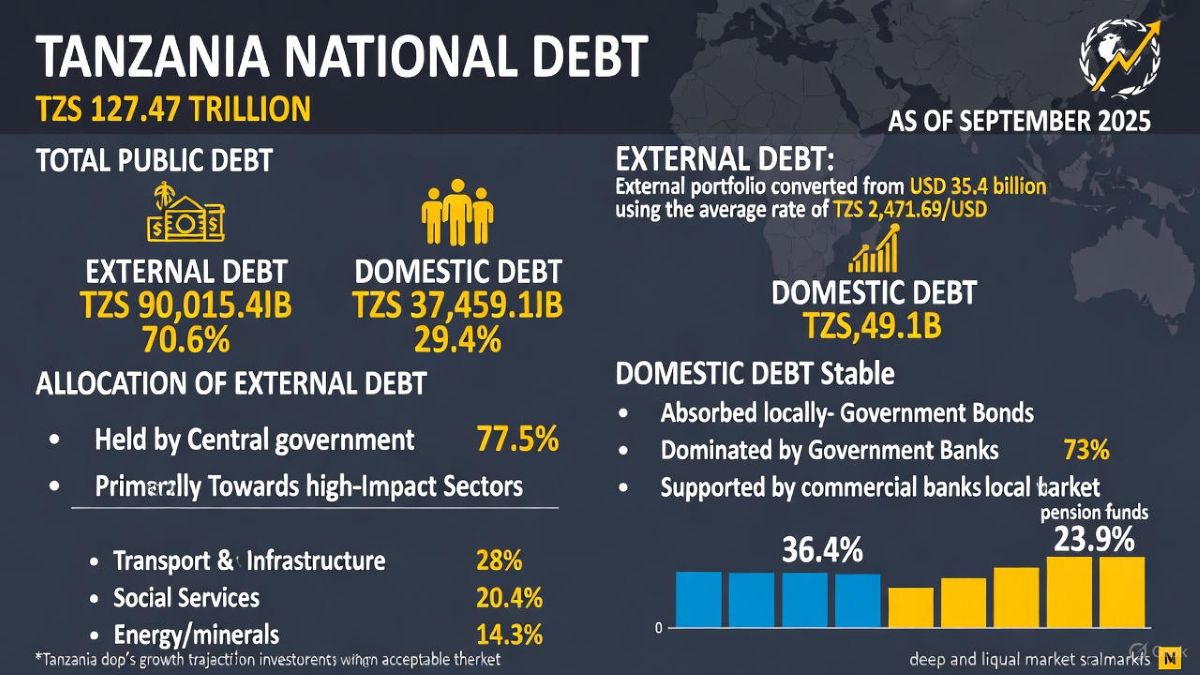
As of September 2025, Tanzania’s total public debt stood at TZS 127,474.5 billion, with external debt accounting for 70.6% (TZS 90,015.4 billion) and domestic debt contributing 29.4% (TZS 37,459.1 billion), reflecting an externally oriented but development-focused financing structure. The external portfolio—converted from USD 35.4 billion using the average rate of TZS 2,471.69/USD—is primarily held by the central government (77.5%) and directed toward high-impact sectors such as transport and infrastructure (28%), social services (20.4%), and energy/minerals (14.3%). Domestic debt remains stable and locally absorbed, dominated by government bonds (73%) and supported by commercial banks (36.4%) and pension funds (23.9%), indicating a deep and liquid local market. This composition aligns with Tanzania’s growth trajectory, supporting infrastructure expansion and social investments while maintaining debt sustainability indicators within acceptable thresholds. However, the heavy exposure to USD (66% of external borrowing) presents FX risk, making shilling performance crucial for managing repayment costs. Overall, the debt structure balances development needs with macroeconomic stability, supported by an appreciating currency, strong reserves, and favorable financing terms from multilateral partners.
Tanzania’s total public debt consists of external debt and domestic debt.
Summary Table — National Debt (TZS)
| Debt Category | Amount (TZS Billion) | Notes |
| External debt stock | 90,015.4 billion | Converted from USD 35.4bn using average rate TZS 2,471.69/USD 2025110720064684 |
| Domestic debt stock | 37,459.1 billion | From BoT monthly review 2025110720064684 |
| Total public debt | 127,474.5 billion | Combination of external + domestic |
The external debt is originally reported in USD.
The report’s exchange rate is:
Domestic debt is already in TZS in the document:
3.1 External Debt Stock by Borrower
| Borrower Category | Amount (USD Million) | Amount (TZS Billion) | % Share |
| Central Government | 27,461.3 | 67,854.5 | 77.5% |
| Private Sector | 5,357.0 | 13,231.0 | 15.1% |
| Government Guaranteed | 2,619.9 | 6,466.0 | 7.4% |
| Total | 35,438.2 | 90,015.4 | 100% |
(All USD values from document summary)
| Sector / Use of Funds | Amount (USD Million) | Amount (TZS Billion) | % Share |
| Transport & Infrastructure | 9,910.4 | 24,508.1 | 28.0% |
| Social services (Education & Health) | 7,238.1 | 17,895.8 | 20.4% |
| Energy & Minerals | 5,058.7 | 12,506.2 | 14.3% |
| Agriculture & Water | 4,964.3 | 12,280.9 | 14.0% |
| Finance & Insurance | 1,794.7 | 4,436.6 | 5.1% |
| Industry & Trade | 1,494.9 | 3,691.7 | 4.2% |
| Others | 4,977.1 | 12,703.7 | 14.0% |
| Total | 35,438.2 | 90,015.4 | 100% |
✔ Converted using TZS 2,471.69/USD.
4.1 Domestic Debt Structure by Creditor Category
| Creditor Category | Share (%) | Amount (TZS Billion) |
| Commercial Banks | 36.4% | 13,626.1 |
| Pension Funds | 23.9% | 8,946.7 |
| Other Financial Institutions | 39.7% | 14,886.3 |
| Total Domestic Debt | 100% | 37,459.1 |
| Instrument Type | Share (%) | Amount (TZS Billion) |
| Government Bonds | 73% | 27,349.1 |
| Treasury Bills | 27% | 10,110.0 |
| Total | 100% | 37,459.1 |
| Component | Amount (TZS Billion) | % of Total |
| External Debt | 90,015.4 | 70.6% |
| Domestic Debt | 37,459.1 | 29.4% |
| Total Debt | 127,474.5 | 100% |
| Item | External Debt (TZS bn) | Domestic Debt (TZS bn) | Total (TZS bn) |
| Debt Stock | 90,015.4 | 37,459.1 | 127,474.5 |
| Share of Total | 70.6% | 29.4% | 100% |
| Main Creditors | Multilaterals, Bilaterals | Banks, Pension Funds | — |
| Primary Risks | FX risk (USD) | Refinancing risk | — |
The breakdown of Tanzania's national debt as of September 2025, detailed in Section 2.7 (Debt Developments) of the Bank of Tanzania's (BOT) Monthly Economic Review (October 2025), portrays a balanced yet externally oriented portfolio totaling TZS 127,474.5 billion (equivalent to ~USD 51.6 billion at TZS 2,471.69/USD). External debt dominates at 70.6% (TZS 90,015.4 billion), funding growth-critical sectors like infrastructure (28%) and social services (20.4%), while domestic debt (29.4%, TZS 37,459.1 billion) relies on stable local institutions (e.g., banks 36.4%, pensions 23.9%). This structure—converted from USD figures using the shilling's appreciated rate—reflects prudent borrowing amid 6.3% Q2 GDP growth, low 3.4% inflation, and a TZS 618.5 billion fiscal deficit (partly debt-financed). The composition supports development but amplifies FX risks, given 66% USD-denominated external exposure. Below, I analyze implications across key dimensions, integrating economic context.
1. Debt Composition: External Dominance for Growth Financing
2. Sustainability and Servicing Dynamics
3. Fiscal and Macroeconomic Linkages
4. Policy Context from the Review
| Component | Amount (TZS Billion) | % of Total | Key Implication |
| External Debt | 90,015.4 | 70.6% | Funds infra/social growth; FX risk from USD (66%). |
| └ Central Govt | 67,854.5 | 77.5% (of external) | Sovereign focus; concessional (57% multilateral). |
| └ Infra/Transport | 24,508.1 | 28% (of external) | Boosts GDP via construction/mining. |
| Domestic Debt | 37,459.1 | 29.4% | Stable local absorption; bonds (73%) for duration. |
| └ Commercial Banks | 13,626.1 | 36.4% (of domestic) | Liquidity tie to IBCM surge (+37.4%; Section 2.5). |
| Total Debt | 127,474.5 | 100% | Sustainable at 40.1% GDP; supports 6% growth projection. |
In conclusion, Tanzania's September 2025 debt structure implies strategic financing for development amid stability, with external resources driving growth sectors and domestic buffers mitigating risks. The 70.6% external tilt underscores FX vigilance, but concessional terms and shilling strength ensure sustainability—reinforcing the Review's narrative of prudent policies for 2026 resilience.